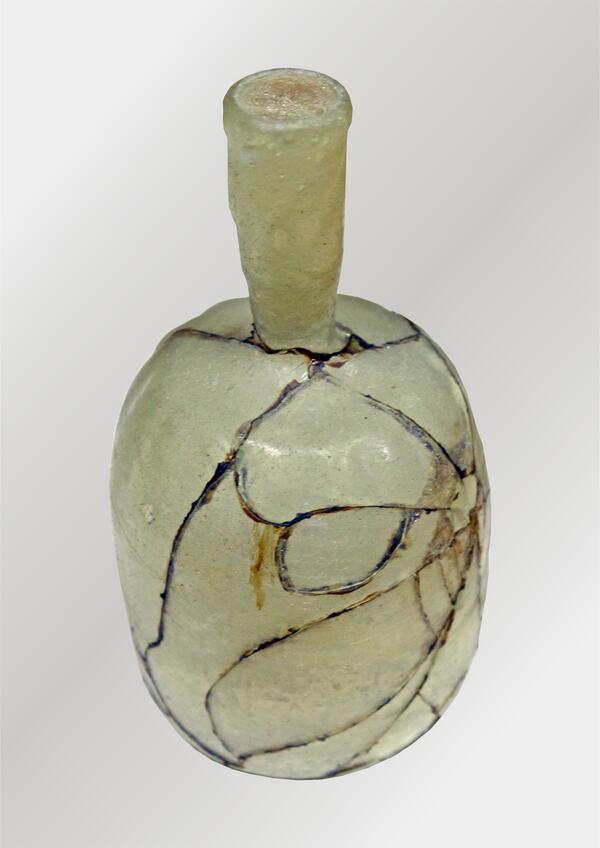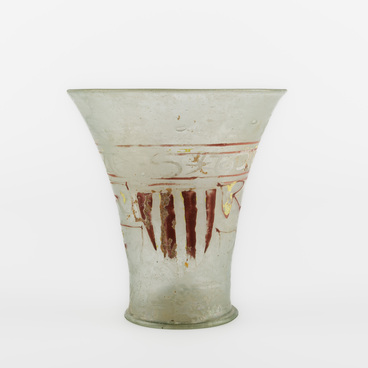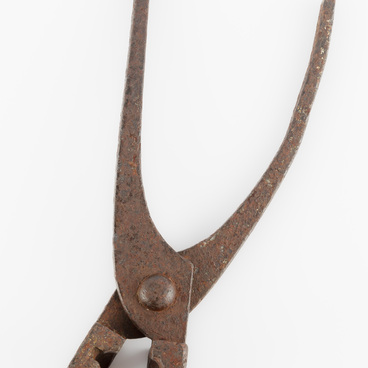In 1983, archaeologists were excavating a warrior’s burial of the 10th–12th centuries. The excavations were overseen by M.G. Mineev, the head of the pre-revolutionary history department. Along with a saber, fragments of a shield, a knife and a fire-striker, the expedition found a small bottle of green glass. Most likely, it was intended to store water or medicines.
In ancient times, glass making was a very complex and time-consuming process. Glass is produced artificially — unlike wood, stone or metal, it does not occur in nature. Therefore, the improvement of production technology and properties of the material led to the higher quality of glass products. Glassblowing required considerable experience and skill. A glass blower had to understand the principles of interaction of materials that make up the glass mass, as well as to know the properties of dyes and bleaching materials. Artisans had to understand the specifics of the temperature regime at each stage of the production. The control of each stage was very important: it depended on the glass blower whether the molten glass would turn into a beautiful bottle, jug, glass, or bead — or whether it would remain a shapeless piece of glass. All this led to glass products being quite expensive. Transparent glass was especially valued. The cleaner and more transparent it was, the more the vessel would cost.
Glass began to gain popularity because it was a convenient storage material: glass practically does not interact with other substances and protects the content of the vessel from the external environment. However, we all know how fragile this material is, so it is very difficult to transport glass products. Imported glass vessels began to be widely used on the Black Sea coast of the Caucasus in the era of the Greek colonization and would cost a lot of money. They were given as presents, exchanged, and used to keep valuable medicines and aromatic oils.
In the Middle Ages, glass became more accessible in the Northwest Caucasus, but in most cases it was inferior in quality to antique glass. This was due to the gradual deterioration of the ancient centers of production. Some techniques were lost, and it took decades to reproduce them.
In ancient times, glass making was a very complex and time-consuming process. Glass is produced artificially — unlike wood, stone or metal, it does not occur in nature. Therefore, the improvement of production technology and properties of the material led to the higher quality of glass products. Glassblowing required considerable experience and skill. A glass blower had to understand the principles of interaction of materials that make up the glass mass, as well as to know the properties of dyes and bleaching materials. Artisans had to understand the specifics of the temperature regime at each stage of the production. The control of each stage was very important: it depended on the glass blower whether the molten glass would turn into a beautiful bottle, jug, glass, or bead — or whether it would remain a shapeless piece of glass. All this led to glass products being quite expensive. Transparent glass was especially valued. The cleaner and more transparent it was, the more the vessel would cost.
Glass began to gain popularity because it was a convenient storage material: glass practically does not interact with other substances and protects the content of the vessel from the external environment. However, we all know how fragile this material is, so it is very difficult to transport glass products. Imported glass vessels began to be widely used on the Black Sea coast of the Caucasus in the era of the Greek colonization and would cost a lot of money. They were given as presents, exchanged, and used to keep valuable medicines and aromatic oils.
In the Middle Ages, glass became more accessible in the Northwest Caucasus, but in most cases it was inferior in quality to antique glass. This was due to the gradual deterioration of the ancient centers of production. Some techniques were lost, and it took decades to reproduce them.



